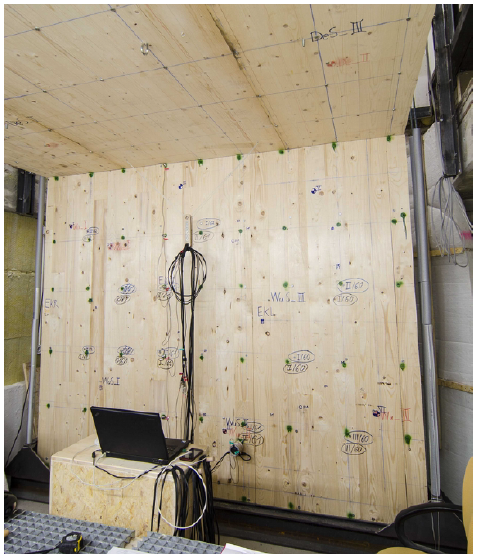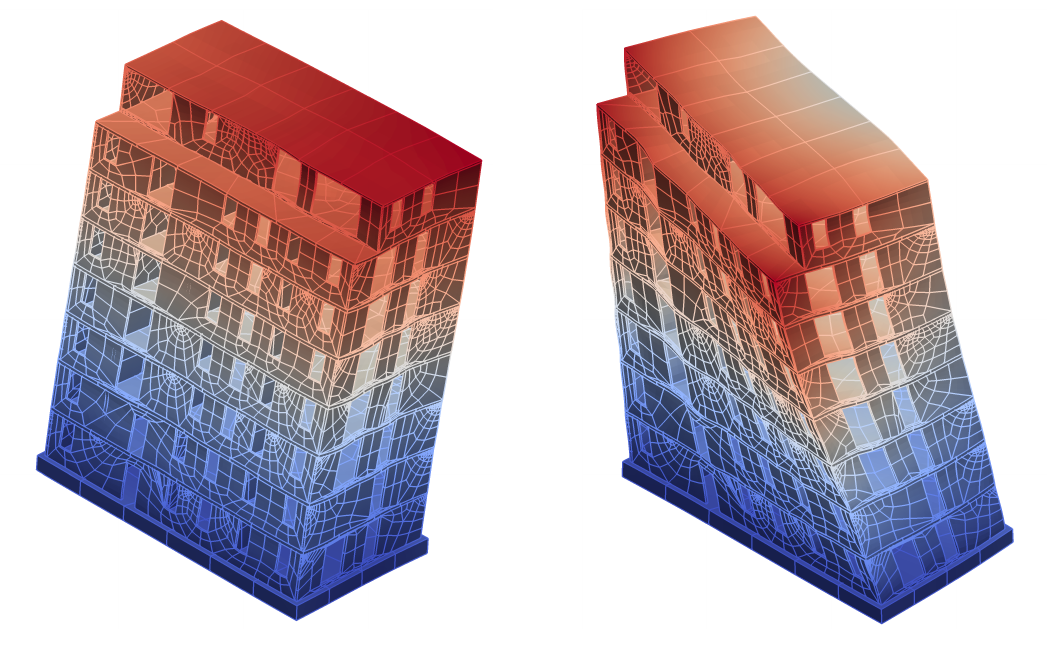BIM-coupled vibroacoustic simulation
Vibroacoustic analysis embedded in the planning process of solid timber buildings
Introduction
Solid timber constructions allow for efficient and sustainable solutions in civil engineering. However, sound insulation requirements must be assured in the planning phase, which is a non-trivial problem, especially in the case of multi-story buildings. In the low and mid frequency range, a comprehensive model of the solid timber components including their connections is necessary. Therefore, numerical methods such as the finite element method and the energy flow analysis are well suited to predict the vibro-acoustic behavior of solid timber buildings.
Generation of the simulation model
A new procedure for vibration analysis of solid timber buildings was developed. It is seamlessly integrated in the computer-aided planning process. In this method, an efficient hexahedral finite element model is created automatically from a Building Information Model. The use of volumetric elements enables a correct representation of three-dimensional displacement fields. Thus, connections between components, possibly including an elastomer layer, can be modeled realistically.
For generating the simulation model, each component is meshed individually. Hence, meshes can be created for geometrically complex buildings and mesh refinements at junctions can be avoided. However, this approach leads to a non-conforming mesh in which connections between the components are not directly considered. In order to couple the components, a modified mortar-method is used. The mortar-method was extended such that flexible connections can be represented with sufficient accuracy. Applying the p-version of the finite element method in combination with a coarse mesh enabled by the component-based approach allows for an accurate solution with a relatively small number of degrees of freedom. Even very thin-walled structures can be modeled efficiently with volumetric p-elements [1].

Verification and validation
Simulation models for coupled solid timber components were verified and validated in two steps. First, a conforming high order finite element model for a solid timber assembly was validated by vibration measurements conducted by Rosenheim University of Applied Sciences, in one case with elastomer layer between the components and in the other without. In this study, the material parameters of timber according to DIN standard and those of the elastomer calculated from the manufacturer’s data sheet proofed to be very well suited [2]. Secondly, mortar-based simulation models for frequency response analyses were verified by comparing them with conforming ones [3].

The integration of the vibration analysis in the computer-aided planning process was validated with a multi-storey timber building. To this end, a hexahedral finite element model was derived from the Building Information Model and the calculated lowest natural frequencies were compared to measurement results [1].


Furthermore, the influence of hierarchical high order shape functions on the computational costs for vibration analyses was investigated. For this purpose, the h- and p-version of the finite element method were compared by means of a representative example in the frequency range which is relevant for building acoustics. The results show that the greatest efficiency was attained with high order shape functions [4].
Publications
|
[1] Paolini, A.; Frischmann, F.; Kollmannsberger, S.; Rabold, A.; Horger, T.; Wohlmuth, B.; Rank, E.: BIM gestützte strukturdynamische Analyse mit Volumenelementen höherer Ordnung. Bauingenieur, 93(4), pp. 160-166, 2018, link.
|
| [2] Paolini, A.; Kollmannsberger, S.; Winter, C.; Buchschmid, M.; Müller, G.; Rabold, R.; Mecking, S.; Schanda, U.; Rank, E.: A high order finite element model for vibration analysis of cross laminated timber assemblies. Building Acoustics, 24(3), pp. 135-158, 2017, DOI: 10.1177/1351010X17727126. |
| [3] Paolini, A.; Kollmannsberger, S.; Rank, E.; Horger, T.; Wohlmuth, B.: A mortar formulation including viscoelastic layers for vibration analysis. Computational Mechanics, 2018, DOI: 10.1007/s00466-018-1582-9. |
| [4] Paolini, A.; Winter, C.; Müller, G.; Kollmannsberger, S.; Rank, E.: Vergleich der h- und p-Version der FEM zur Prognose des Körperschalls in Massivholzkonstruktionen. In: Fortschritte der Akustik, DAGA 2018, München, Deutschland, 2018, link. |